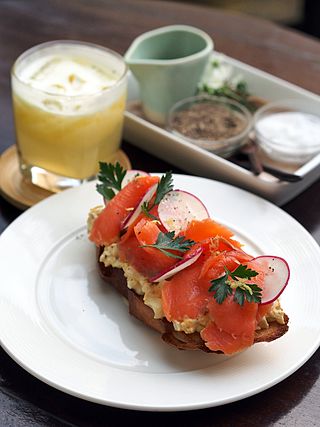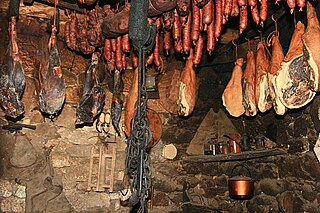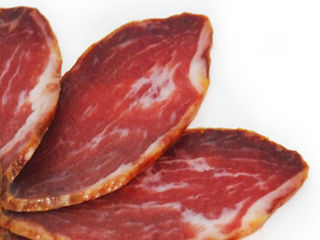
Smoked cheese is any cheese that has been specially treated by smoke-curing. [1] It typically has a yellowish-brown outer pellicle which is a result of this curing process. [2]

Smoked cheese is any cheese that has been specially treated by smoke-curing. [1] It typically has a yellowish-brown outer pellicle which is a result of this curing process. [2]
Smoke-curing is typically done in one of two ways: cold-smoking and hot-smoking. [1] The cold-smoking method (which can take up to a month, depending on the food) smokes the food at between 20° and 30° C (68° and 86° F). Hot-smoking partially or completely cooks the food by treating it at temperatures ranging from 40° to 90 °C (104° to 194° F).
Another method, typically used in less expensive cheeses, is to use artificial smoke flavoring to give the cheese a smoky flavoring and food coloring to give the outside the appearance of having been smoked in the more traditional manner.
Some smoked cheeses commonly produced and sold include smoked Gruyère, smoked Gouda (rookkaas), Provolone, Rauchkäse, Scamorza, Sulguni, Oscypek, Fynsk rygeost, and smoked Cheddar. [1] [3] [4] [5]

Ham is pork from a leg cut that has been preserved by wet or dry curing, with or without smoking. As a processed meat, the term ham includes both whole cuts of meat and ones that have been mechanically formed.

A kipper is a whole herring, a small, oily fish, that has been split in a butterfly fashion from tail to head along the dorsal ridge, gutted, salted or pickled, and cold-smoked over smouldering wood chips.

Barbecue or barbeque is a term used with significant regional and national variations to describe various cooking methods that employ live fire and smoke to cook the food. The term is also generally applied to the devices associated with those methods, the broader cuisines that these methods produce, and the meals or gatherings at which this style of food is cooked and served. The cooking methods associated with barbecuing vary significantly but most involve outdoor and indoor cooking.

Smoking is the process of flavoring, browning, cooking, or preserving food, particularly meat, fish and tea, by exposing it to smoke from burning or smoldering material, most often wood.

Smoked salmon is a preparation of salmon, typically a fillet that has been cured and hot or cold smoked.

Biltong is a form of air-dried, cured meat which originated in South Africa, and from there spread to other Southern African countries --. Various types of meat are used to produce it, ranging from beef to game meats such as ostrich or kudu. The cut may also vary being either fillets of meat cut into strips following the grain of the muscle, or flat pieces sliced across the grain. It is related to beef jerky, as both are spiced, dried meats; however, the typical ingredients, taste, and production processes may differ. Biltong is air-dried, which gives it a unique texture and taste, whereas jerky is heated to at least 71 °C (160 °F).

Carbonara is a pasta dish made with fatty cured pork, hard cheese, eggs, salt, and black pepper. It is typical of the Lazio region of Italy. The dish took its modern form and name in the middle of the 20th century.

Fondue is a Swiss dish of melted cheese and wine served in a communal pot over a portable stove heated with a candle or spirit lamp, and eaten by dipping bread and sometimes vegetables or other foods into the cheese using long-stemmed forks. It was promoted as a Swiss national dish by the Swiss Cheese Union in the 1930s, and was popularized in North America in the 1960s.

Smoked meat is the result of a method of preparing red meat, white meat, and seafood which originated in the Paleolithic Era. Smoking adds flavor, improves the appearance of meat through the Maillard reaction, and when combined with curing it preserves the meat. When meat is cured then cold-smoked, the smoke adds phenols and other chemicals that have an antimicrobial effect on the meat. Hot smoking has less impact on preservation and is primarily used for taste and to slow-cook the meat. Interest in barbecue and smoking is on the rise worldwide.

The origins of meat preservation are lost to the ages but probably began when humans began to realize the preservative value of salt. Sausage making originally developed as a means to preserve and transport meat. Primitive societies learned that dried berries and spices could be added to dried meat. The procedure of stuffing meat into casings remains basically the same today, but sausage recipes have been greatly refined and sausage making has become a highly respected culinary art.

Smoked fish is fish that has been cured by smoking. Foods have been smoked by humans throughout history. Originally this was done as a preservative. In more recent times fish is readily preserved by refrigeration and freezing and the smoking of fish is generally done for the unique taste and flavour imparted by the smoking process.

Curing is any of various food preservation and flavoring processes of foods such as meat, fish and vegetables, by the addition of salt, with the aim of drawing moisture out of the food by the process of osmosis. Because curing increases the solute concentration in the food and hence decreases its water potential, the food becomes inhospitable for the microbe growth that causes food spoilage. Curing can be traced back to antiquity, and was the primary method of preserving meat and fish until the late 19th century. Dehydration was the earliest form of food curing. Many curing processes also involve smoking, spicing, cooking, or the addition of combinations of sugar, nitrate, and nitrite.
Rauchkäse is a German variety of smoked cheese, known for being semi-soft with a smoky brown rind. The most famous variety is Bruder Basil, named for dairy entrepreneur Basil Weixler, whose dairy company is still in operation today. It is typically smoked using birch or spruce woods.

Oscypek, rarely Oszczypek, is a smoked cheese made of salted sheep milk exclusively in the Tatra Mountains region of Poland. Oscypek is made by an expert named "baca", a term also denoting a shepherd in the mountains. The cheese is a traditional holiday cheese in some European countries and is often pan fried and served with cranberry jam (żurawina) on the side.

Cured fish is fish which has been cured by subjecting it to fermentation, pickling, smoking, or some combination of these before it is eaten. These food preservation processes can include adding salt, nitrates, nitrite or sugar, can involve smoking and flavoring the fish, and may include cooking it. The earliest form of curing fish was dehydration. Other methods, such as smoking fish or salt-curing also go back for thousands of years. The term "cure" is derived from the Latin curare, meaning to take care of. It was first recorded in reference to fish in 1743.

Cured pork tenderloin is found in various cuisines in Mediterranean Europe and South America. It is typically salted or brined then dry-cured or smoked.